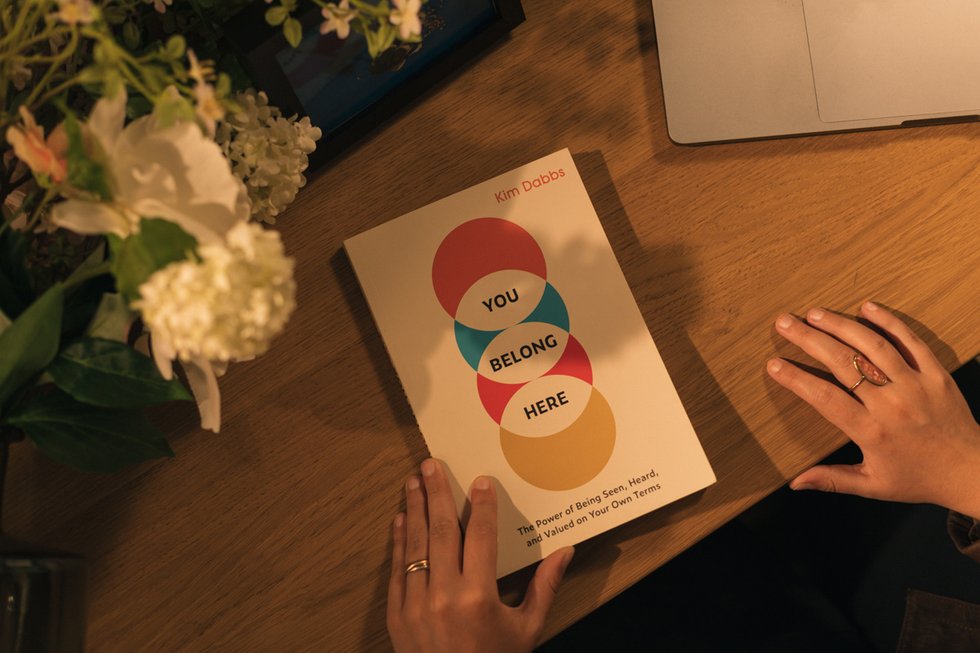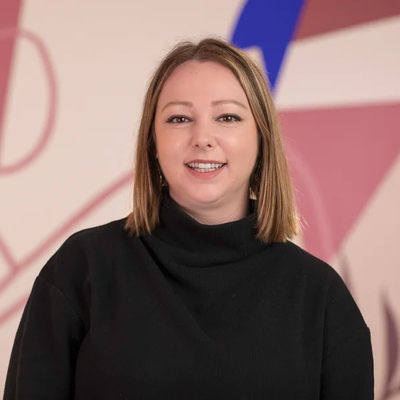Where do I fit? Redefining identity in a world of differences
Jun 24, 2024
8 mins


US Editor at Welcome to the Jungle
Do you ever feel like an outsider in your life? Kim Dabbs’ new book, You Belong Here, addresses this common experience with a nuanced look at identity. Drawing from her unique perspective as a Korean-born American adoptee living in Munich, Germany, Dabbs navigates the complex interplay between self-perception and societal acceptance. She uses her personal narrative as a backdrop for broader reflection, exploring what it means to find one’s place in the world.
Through her own stories and those of changemakers around the globe, she challenges and redefines the notion of belonging. Her book is not just a reflection on personal identity but a call to action, urging readers to reconsider how environments—be they professional, social, or familial—can be shaped to foster true inclusivity.
We spoke with Dabbs to explore the most pressing themes of her work: How do we define ourselves in a world that often feels alienating? What role do our surroundings play in shaping our sense of belonging?
Let’s start with your book, You Belong Here. What inspired you to write it?
For me, being a Korean-born American adoptee currently living in Munich, Germany, I’ve always felt like the world was made up of places where I didn’t belong. Throughout my life, I grappled with the concept of belonging, trying to understand what it meant for me. During COVID-19, I explored my place and purpose in the world. My background in the nonprofit sector and public policy led me to believe my path was social impact. But I discovered it was more about the intersection of purpose and identity. I interviewed amazing changemakers worldwide to understand belonging and how people bring it to life.
That sounds like a profound journey. How did your personal understanding and experience of belonging evolve during this time?
I realized that often, I let the outside world define my identity. By doing so, I didn’t allow myself or others to create spaces where we could truly belong. My perspective shifted to focus on how I want to be seen, heard, and valued. This change affected how I interact with people, how I show up in my work, and how I engage with my family and community. It’s about creating environments where others can do the same.
You also emphasize self-definition as a means of empowerment. Can you explain this more?
When we think about belonging, if you deconstruct the word, “be” means to exist, and “long” refers to the desire. We are all constantly longing to exist. Belonging begins with the individual, not something that happens externally. We all have felt like outsiders at some point. Belonging starts when we stop looking to the outside world to define it and start doing the work on ourselves. When we define how we want to be seen, heard, and valued, we begin to belong. Without this foundation, people continue to wear masks to fit in, impacting our cultures at home, work, and in the world.
To help us define ourselves, you introduce the idea of four identities: Lived, Learned, Lingering, and Loved. Can you elaborate on how you developed this framework and its importance?
The belonging journey involves exploring our four identities. Each plays a crucial role in understanding who we are and how we navigate our personal and professional lives.
Lived identity
Lived identity encompasses traits we inherit and cannot change. It’s what people often refer to when they talk about diversity. Our lived identity includes aspects such as our race, gender, and cultural background—those inherent characteristics that shape our experiences and perspectives. Understanding our lived identity is essential because it helps us see how our cultures and systems impact our sense of self. When we introduce ourselves, we often emphasize or omit parts of our lived identity based on the context, which can reveal a lot about what we perceive as acceptable or valuable in different settings.
For instance, when we meet someone new, we might say, “Hi, I’m Kim, and I work in public policy,” but we might leave out, “I’m an adoptee.” This omission often happens subconsciously because we are conditioned to present parts of ourselves that we believe will be accepted or valued in a given context. Recognizing these patterns is crucial in understanding how deeply our lived identity influences our interactions.
Learned identity
Learned identity covers the choices we make in life, including our professions, education, relationships, and other significant life decisions. Unlike our lived identity, our learned identity is dynamic and can change over time. It reflects our personal growth and development. When discussing equity, it’s crucial to consider whether people have equitable access to the choices that shape their learned identity.
For instance, do individuals have equal opportunities to pursue their desired education or careers? Our learned identity constantly evolves as we make new decisions and embrace new opportunities. Consider someone who decides to go back to school later in life to change careers. This decision reflects their learned identity. It’s a choice that signifies growth and a shift in how they see themselves and their potential.
However, not everyone has the same access to opportunities to make such choices, which brings inequity. Are we providing the same educational opportunities to all individuals, regardless of their background? Equity in access to these choices is fundamental in allowing people to shape their learned identity.
Lingering identity
Lingering identity involves the stories and experiences that continue to influence us, even if they no longer align with our present reality. It’s about the inclusion lens—how we are included in communities and workplaces, yet we might not feel like we truly belong.
For example, you might have a seat at the table, but do you feel safe and valued there? When we face situations that trigger old narratives or insecurities, our lingering identity can take over, leading us to respond based on past experiences rather than present realities. It’s essential to recognize these lingering stories and actively work to rewrite them, allowing ourselves to move forward without being held back by outdated beliefs.
For instance, someone might have been told early in their career that they were not leadership material. Even if they now hold a leadership position, that lingering identity can make them doubt their abilities. They might second-guess their decisions or feel like an imposter. Recognizing and addressing these lingering identities involves actively rewriting these old stories and replacing them with affirmations that reflect their current capabilities and achievements.
Loved identity
Loved identity is the culmination of all the other identities. It’s the space where authenticity and belonging truly thrive. When we have embraced our lived, learned, and lingering identities, we can fully claim our loved identity. It’s about being seen, heard, and valued for who we genuinely are. The loved identity represents the ultimate sense of belonging, where we can show up as our true selves without fear or pretense.
The loved identity is about self-acceptance and the acceptance of others. At this point, we can look at ourselves and acknowledge all parts of our identity without shame or fear. This is where true authenticity lies. It’s not about fitting into someone else’s mold but embracing our unique combination of lived, learned, and lingering identities. This acceptance allows us to interact with others from a place of empathy and understanding, fostering deeper connections and a stronger sense of community. Developing this framework was a process of deep exploration and understanding.
By examining these four identities, individuals can gain a comprehensive view of themselves and their interactions with the world to help them navigate professional environments effectively and foster a sense of belonging.
So, if understanding these identities helps us create or rewrite our personal narratives, how does changing your narrative impact your sense of belonging?
Changing your narrative helps you understand and redefine the stories you tell yourself. For example, I once spoke with a woman who felt she wasn’t professional enough in her workplace. We discussed what “professional” meant to her. She realized it was about bringing her best skills to work and advancing a cause, not fitting a specific image. This understanding allowed her to change jobs and feel more confident in her new role. It’s about deciding what your story is and not letting external definitions limit you.
When you change your narrative, you shift your perspective on your capabilities and potential. It allows you to see your value and contributions in a new light, fostering a deeper sense of belonging. This self-awareness and confidence can transform how you interact with others and how you perceive your place in various settings, from professional environments to personal relationships.
Can you share a technique or exercise from the book that someone can use to start rewriting their personal narratives?
A good exercise is to list all the “I’m too” statements about yourself. For example, “I’m not professional enough” or “I’m too radical.” These statements often highlight our greatest strengths. By examining these statements, we can start to understand the stories we tell ourselves and begin to rewrite them. For instance, questioning what “professional” means and who defines it can lead to a more empowering narrative.
Another technique is to look at the strengths within these “I’m too” statements. For example, “I’m too radical” might actually reflect a strength in innovative thinking and the ability to challenge the status quo, which can be incredibly valuable in many professional contexts.
Many workers struggle with maintaining their authentic selves in professional settings. What advice would you give?
I encourage everyone to do the inner work before entering a professional setting. Invest in understanding yourself and how you want to be seen, heard, and valued. Understand your strengths, values, and the unique qualities you bring to the table. This foundation allows you to navigate professional settings with confidence and integrity. It also helps you recognize and advocate for the kind of work environment where you and your colleagues can thrive.
Where do you see the line between authenticity and professional expectations? How would you define the balance?
I think people expect good work, I do—and that, to me, is professional, right? If I can do my work in a way that honors myself, that’s where authenticity and professionalism come together. If these are in conflict, it’s important to question if the environment is right for you or if you can impact the culture to align better with your values.
Balancing authenticity and professional expectations involves aligning personal values with professional goals. Authenticity doesn’t mean abandoning professional standards; it means bringing your authentic self to your work. It’s about delivering quality work while staying true to your principles and personality. If you find that your authenticity is consistently at odds with professional expectations, it might be worth considering whether you are in the right environment or if there are ways to influence the culture to be more inclusive.
What emerging trends or challenges do you see concerning identity and belonging in today’s society?
Identity is being fundamentally challenged, especially in the Americas. The backlash against diverse identities is destructive and causes pain. We need courageous conversations and civil discourse to bridge differences. The hard work will be to learn to live and connect around our differences.
The current socio-political climate has intensified the challenges around identity and belonging. There’s a growing need for spaces where people can engage in meaningful conversations about these issues. This requires a commitment to empathy, understanding, and active listening. Organizations and communities must prioritize creating environments where diverse identities are respected and valued. They also need to make space for inner work and exploration.
Bridging and connecting over differences isn’t just a personal issue or a business issue—it’s a human issue. In every aspect of our lives, we need to make space for these conversations and allow exploration to thrive.
Finally, what top advice would you give?
Come as you are. Define your identity and understand how you want to be seen, heard, and valued. This will open your eyes to yourself and others’ journeys. When you understand your purpose, you can share it with others and create spaces where everyone belongs.
Photo by Thomas Decamps for Welcome to the Jungle
Follow Welcome to the Jungle on Facebook, LinkedIn, and Instagram and subscribe to our newsletter to get our latest articles every week!

More inspiration: DEI

Sh*t’s broken—Here’s how we fix work for good
Built by and for a narrow few, our workplace systems are in need of a revolution.
Dec 23, 2024

What Kamala Harris’s legacy means for the future of female leadership
The US presidential elections may not have yielded triumph, but can we still count a victory for women in leadership?
Nov 06, 2024

Leadership skills: Showing confidence at work without being labeled as arrogant
While confidence is crucial, women are frequently criticized for it, often being labeled as arrogant when they display assertiveness.
Oct 22, 2024

Pathways to success: Career resources for Indigenous job hunters
Your culture is your strength! Learn how to leverage your identity to stand out in the job market, while also building a career
Oct 14, 2024

Age does matter, at work and in the White House
What we've learned from the 2024 presidential elections about aging at work.
Sep 09, 2024
The newsletter that does the job
Want to keep up with the latest articles? Twice a week you can receive stories, jobs, and tips in your inbox.

Looking for your next job?
Over 200,000 people have found a job with Welcome to the Jungle.
Explore jobs